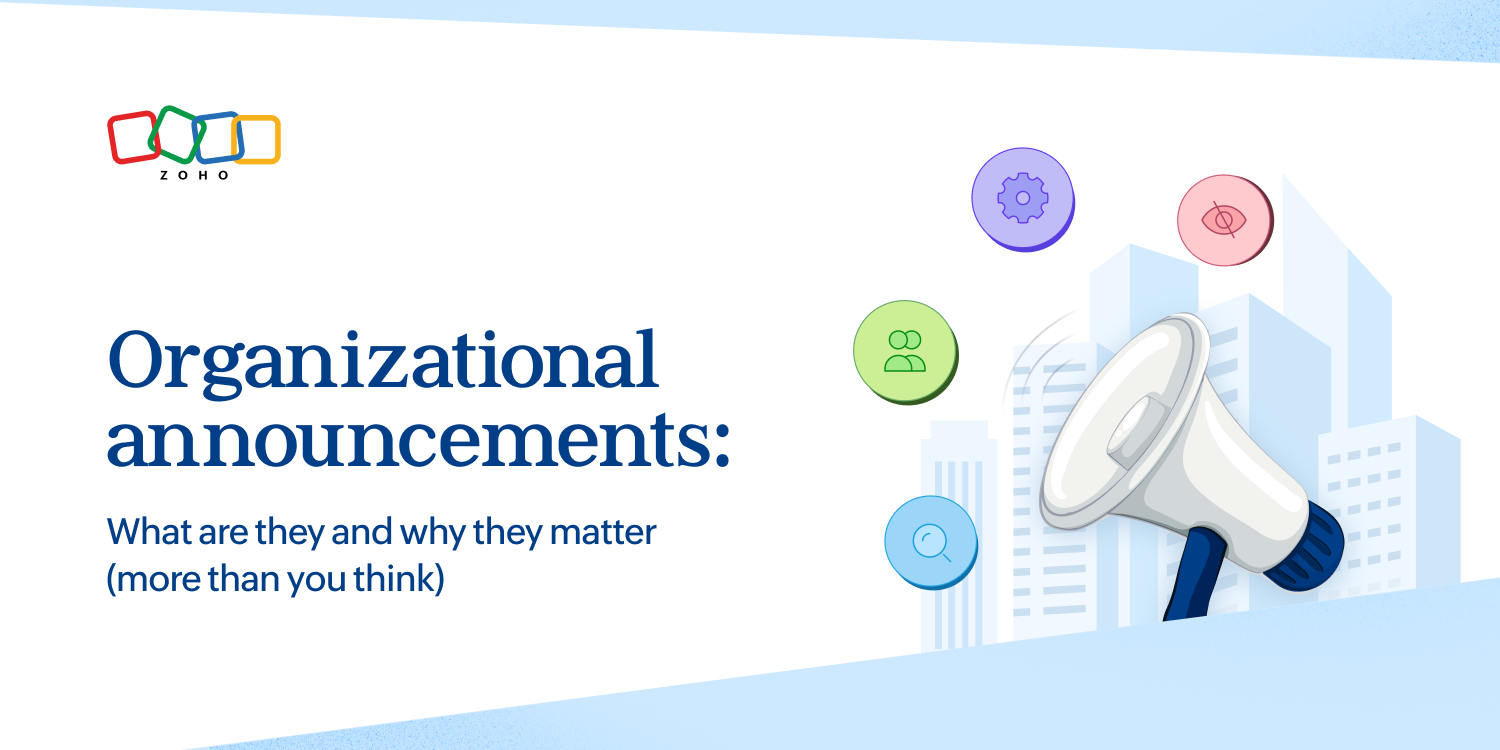- HOME
- All Products
- Collaboration
- Team Communication: A comprehensive primer for 2024
Team Communication: A comprehensive primer for 2024
- Published : October 22, 2024
- Last Updated : December 20, 2024
- 757 Views
- 6 Min Read
There's a lot that goes into collaborating effectively as a team. Each individual needs a robust set of skills to contribute, leaders need to give everyone a clear goal to shoot for, and the team needs to adjust the way they do things when issues pop up.
But there's a single skill sitting at the core of all this: team communication.
Let's define this essential skill, cover why it matters, and find ways to help your team improve.

What is team communication?
There's a lot that goes into collaborating effectively as a team. Each individual needs a robust set of skills to contribute, leaders need to give everyone a clear goal to shoot for, and the team needs to adjust the way they do things when issues pop up.
But there's a single skill sitting at the core of all this: team communication.
Let's define this essential skill, cover why it matters, and find ways to help your team improve.
Why team communication matters
Because teams usually collaborate internally more often than they work with other teams, being able to communicate effectively among themselves is crucial. Here’s why.
It’s part of everything that makes your organization money
You’ll be hard-pressed to find a project or initiative that doesn’t depend on team communication. Teams with strong communication skills get more done in less time—which is great for the organization’s bottom line.
It’s essential to team cohesion
A team that can’t communicate effectively will fall prey to issues that challenge its cohesion. Great teams need to come together to do great things, and communication is essential for doing that. After all, if you’re second-guessing everything your team says, it’s hard to work as one.
It prevents misunderstandings
An ill-timed misunderstanding can sink a project—and it can be avoided with strong communication skills. Can you think of a situation where better communication doesn’t lead to a better result? Misunderstandings can be caused by a mismatch in communication skills, misuse of a communication channel, or even not making communication a high enough priority.
It’s essential to company culture
Company culture can have a massive impact on employee retention, morale, and even individual performance. But culture doesn’t trickle down from the C-suite with documents and processes. It’s established in constant communication at every level of the org chart.
The 3 types of team communication
Most teams use a wide variety of communication channels and methods to get aligned on their priorities, share important updates, and keep in touch. But all of these fall within three broad categories: verbal communication, written communication, and non-verbal communication. Let’s break them down one by one.
Verbal communication
Anything that involves one person speaking words out loud to one or more people is verbal communication. Examples include:
Face-to-face meetings: Some topics are easier to cover when you get the whole team in a room together.
Video meetings: Meeting through apps like Zoho Meeting can create the same sort of cohesion as a face-to-face meeting from anywhere in the world.
Phone calls: In most organizations, phone calls have been replaced by video meetings and emails, but a quick phone call can be the best way to communicate something.
Presentations: One of the best ways for a single person to communicate a message with multiple people at once.
Impromptu communications: Grabbing someone while they’re at the coffee machine can be a great way to communicate something quickly.
Town hall: This type of communication is often used by leaders to invite feedback and questions from their teams or communicate important information.
Written communication
Write things down to communicate through a medium anyone can refer to later. Here are some ways teams frequently communicate in writing.
Email: A quick email can communicate something important in minutes.
Reports: Teams produce reports to share insights about important projects and team functions. Examples of these include project status reports, risk reports, and sales reports.
Letters: Communicating in this way within a team is rare, but some official messages need to be put on paper.
Press releases: A team might work together to produce a press release for the public, but they’ll rarely use them for internal communications.
Chat: This is one of the most common channels for team communication, using chat apps like Zoho Cliq.
Comments: Collaboration and project management tools allow team members to leave comments about specific projects and tasks, suited to very focused communication.
Non-verbal communication
These communication methods are usually part of verbal communication but are sometimes used on their own.
Body language: Everything from crossing your arms to nodding can communicate a message.
Facial expressions: Scowling or smiling, for example, each communicate something different.
Tone and volume: Shouting, whispering, and speaking sharply are all parts of communication.
The 5 biggest barriers to team communication
When you start taking team communication seriously, you’ll start to notice these barriers pop up: language barriers, psychological and emotional barriers, physical and technological barriers, cultural barriers, as well as organizational barriers.
Language barriers
In teams that span multiple locations—or cultural backgrounds—some team members might have a stronger grasp of your organization’s chosen language. That can easily lead to misunderstandings, and it’s something your team will need to work around.
Psychological and emotional barriers
Emotions and psychological bias can get in the way of accurate team communication. Anger, for example, is an especially strong barrier because it can put blinders on even the best communicators.
Physical and technological barriers
Sometimes a barrier to communication is as simple as a crowded office or an unreliable internet connection. If you’ve ever been on a Zoom call with a spotty internet connection, you know that these issues can completely derail your attempts at communication. At best, they lead to some messages needing to be repeated. At worst, they make any effort to communicate a failure.
Cultural barriers
With a diverse team of individuals, you’ll run into cultural differences that can create barriers to communication. If you lead a team, it’s important that you help everyone navigate through these differences.
Organizational barriers
Some organizations have processes or policies that make communication artificially more difficult. It might be insisting that all communication be done by email, or not making project management applications available for project-based communication.
4 tips to be a better communicator within a team
Ready to get your team aligned on what matters and avoid misunderstandings? Here are some ways everyone in your team can improve the way they communicate.
Know your communication style
According to Dr. Daria S. Lafave, a communication instructor at Southern New Hampshire University, there are four main styles of communication:
Passive communication: This style involves little real communication. People with this style tend to avoid speaking up when they notice problems. They tend to let things slide, which can lead to larger issues down the road.
Aggressive communication: This style is characterized by loud voices and angry statements. Many think that being “aggressive” in communication is the best way to get respect, but it usually just contributes to a toxic work environment.
Passive-aggressive communication: Some with this communication style might say everything’s alright while holding on to negative feelings after you interact with them. This can grow into resentment and make it challenging to keep the team truly aligned.
Assertive communication: This kind of communication strikes a balance between getting your point across effectively and accounting for other people’s perspectives. It’s the best way to share what you care about without being overly aggressive.
If you feel like your communication style falls into any category but assertive communication, then you need to work on becoming a better communicator.
Listen more than you speak
One of the best ways to become a better communicator is to ensure you have an accurate understanding of what the other person involved is saying. It’s hard to do that when you’re focused on what you’re going to say next instead of what’s being said. Learning active listening and how to ask the right questions when you don’t understand something is often more important than how you share your own message.
Learn how to choose the right communication method
Do you know when you should be communicating in writing and when you should pull someone aside for a quick face-to-face chat? Being able to match your communication method to the situation—and the person you’re communicating with—is essential for building a more cohesive team.
Leave out the fluff
It’s tempting to dress up whatever you have to say with famous quotes and clichés, but that can actually get in the way of what you’re trying to communicate. Whether you’re writing something out or presenting for an important meeting, try to get straight to the point.
Make team communication a priority
Team communication is at the core of everything your team does. Being able to accurately communicate what you’re working on, what you need, and your goals is essential to making your team more cohesive. Just watch out for common barriers and work on improving communication across all channels.
 Genevieve Michaels
Genevieve MichaelsGenevieve Michaels is a freelance writer based in France. She specializes in long-form content and case studies for B2B tech companies. Her work focuses on collaboration, teamwork, and trends happening in the workplace. She has worked with major SaaS brands and her creative writing has been published in Elle Canada, Vice Canada, Canadian Art Magazine, and more.


